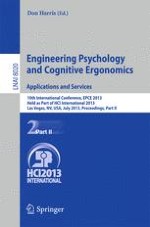This two-volume set (LNAI 8019 and LNAI 8020) constitutes the refereed proceedings of the 10th International Conference on Engineering Psychology and Cognitive Ergonomics, EPCE 2013, held as part of the 15th International Conference on Human-Computer Interaction, HCII 2013, held in Las Vegas, USA in July 2013, jointly with 12 other thematically similar conferences. The total of 1666 papers and 303 posters presented at the HCII 2013 conferences was carefully reviewed and selected from 5210 submissions. These papers address the latest research and development efforts and highlight the human aspects of design and use of computing systems. The papers accepted for presentation thoroughly cover the entire field of human-computer interaction, addressing major advances in knowledge and effective use of computers in a variety of application areas. The total of 81 contributions included in the EPCE proceedings were carefully reviewed and selected for inclusion in this two-volume set. The papers included in this volume are organized in the following topical sections: driving and transportation safety, cognitive issues in aviation, military applications, cognitive issues in health and well-being.
